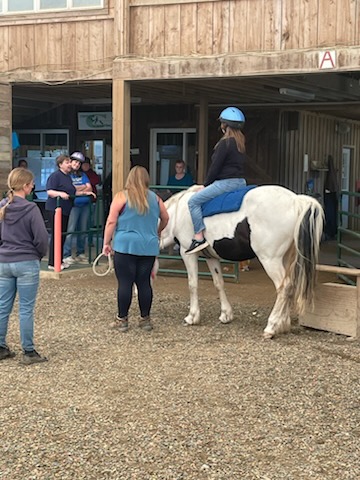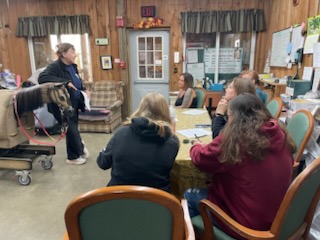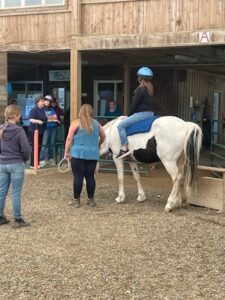Finding Relief By Returning To Saddle

Riding for assessment of posture and movement bareback at Centaur Stride.
- Riding for assessment of posture and movement bareback at Centaur Stride.
- Pictured is a back clinic lecture at Centaur Stride.
But life has a way of shifting perspectives.
In my case, it came through a perfect storm — Lyme disease, long COVID, and a debilitating accident that ended my career five years ago. I didn’t “beat the odds,” and I certainly didn’t bounce back. What I did was learn — again.
Throughout my career, I’ve gravitated toward three forms of holistic movement therapy: swimming, yoga, and therapeutic horseback riding. Each has its merits, but nothing compares to the results I’ve seen (and felt) from riding.
So, what makes therapeutic horseback riding so powerful?

Pictured is a back clinic lecture at Centaur Stride.
Unlike traditional exercise, riding taps into the body’s automatic nervous system. Sitting astride a horse places the hips in their most anatomically stable position. From there, balance reflexes are triggered — naturally activating muscles along the spine and pelvis, up through the torso and down the legs. The horse becomes both therapist and trainer, gently coaxing the body into proper alignment through motion.
This process builds symmetry — the holy grail of pain-free movement. When the muscles on one side of the body mirror those on the other, joints are balanced, posture is stable, and movement becomes efficient. When we lose that symmetry — as we all do through injury, illness, or inactivity–pain and dysfunction creep in. Muscles tighten or lengthen unevenly, joints wear out, and the body begins to break down. The goal of therapy? Restore symmetry and strength.
Swimming is a wonderful tool for gentle, buoyant movement. The water supports the body, allowing for a degree of freedom not possible on land. But it lacks the hip positioning and neuromuscular stimulation unique to horseback riding. In aquatic therapy, I often had to physically position a child’s body to guide their movement. Horses do that for you.
Yoga, too, has its place. When taught correctly, it’s one of the best ways to stretch and strengthen toward optimal alignment. But again — it’s up to the individual to perform the movements, engage the right muscles, and maintain balance. The horse provides an automatic, dynamic platform where the body responds instinctively, often without conscious effort.
As therapists, we prescribe only a handful of exercises tailored to each patient’s specific needs. But riding? It doesn’t even feel like exercise. It feels like freedom. And the exercises include the entire body.
A few weeks ago, I spoke at Centaur Stride’s “Healing with Horses” clinic. I demonstrated how horseback riding could help with back pain and postural issues. Eight participants witnessed a small miracle — one woman, reporting 8 to 10 pain, experienced complete relief after just 40 minutes in the saddle. Even I was stunned by the immediate result.
And then I asked myself: What would it do for me?
I hadn’t ridden in years. After my accident, I mostly stopped going to the barn. My time there had always been spent helping others ride — never taking time for myself. But now, with chronic knee and foot pain, a sedentary lifestyle, and the looming threat of metabolic syndrome, I knew I needed to act. I committed to a personal five-day experiment: one hour of riding per day.
Day One: I was shocked by how stiff I’d become. My pelvis refused to find a neutral position without force. “Pockets to the saddle” felt impossible. My glutes were overactive, my abs nearly absent. I dismounted with trembling legs and the humbling realization of how far I had to go.
Day Two: Something shifted. My pelvis adjusted naturally into alignment. My abdominals began to fire for the first time in years. I felt connected to the horse. We took a trail ride through the woods, and in that peaceful moment, I caught a glimpse of hope–movement beyond limitation.
Even more astonishing: my plantar fasciitis pain was gone. After months of failed self-treatments, it vanished after two rides. My knee pain also eased considerably.
Day Three: I stood in the stirrups — pain-free in my heel. My core was activated. I felt my glutes and abs co-contracting in sync. My knees could tolerate the weight with only minimal pain. Not only was I regaining strength, I was rediscovering joy.
This wasn’t just a return to riding. It was a declaration that natural healing still holds power, that movement and action can bring about so much more healing than pills and passivity never did. And that, as a healer, I must first heal myself. Days four and five just reinforced my new hope.
It’s true, never stop moving, but choose movement that does not cause more pain.
Therapeutic riding may not be for everyone. Certain hip or back surgeries can make it unsafe. Results vary. But for those who are able, it may be an experience worth trying.
To schedule a lesson or learn more, call Centaur Stride at (716) 326-4318.
Claudia Monroe is founder and president of Centaur Stride.



